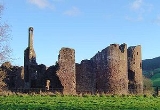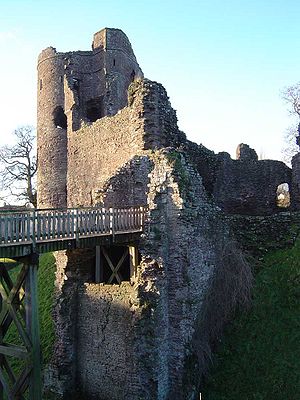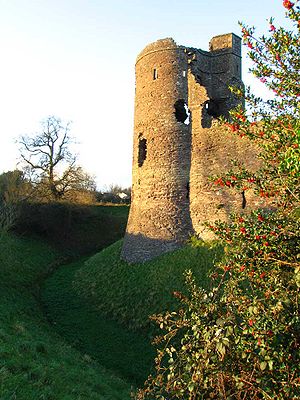
Grosmont Castle
Encyclopedia

Castle
A castle is a type of fortified structure built in Europe and the Middle East during the Middle Ages by European nobility. Scholars debate the scope of the word castle, but usually consider it to be the private fortified residence of a lord or noble...
in Grosmont, Monmouthshire
Grosmont, Monmouthshire
Grosmont is a village in Monmouthshire, Wales near Abergavenny.- History :Grosmont Castle is a major feature of the village and was the birthplace of Henry, 1st Duke of Lancaster. St...
very near the present English / Welsh border, approximately 8 miles northeast of Abergavenny
Abergavenny
Abergavenny , meaning Mouth of the River Gavenny, is a market town in Monmouthshire, Wales. It is located 15 miles west of Monmouth on the A40 and A465 roads, 6 miles from the English border. Originally the site of a Roman fort, Gobannium, it became a medieval walled town within the Welsh Marches...
, between Abergavenny, Hereford
Hereford
Hereford is a cathedral city, civil parish and county town of Herefordshire, England. It lies on the River Wye, approximately east of the border with Wales, southwest of Worcester, and northwest of Gloucester...
and Monmouth
Monmouth
Monmouth is a town in southeast Wales and traditional county town of the historic county of Monmouthshire. It is situated close to the border with England, where the River Monnow meets the River Wye with bridges over both....
.

Grosmont Castle
Grosmont Castle would seem to have been founded after the time of William FitzOsbern, 1st Earl of HerefordWilliam Fitzosbern, 1st Earl of Hereford
William FitzOsbern , Lord of Breteuil, in Normandy, was a relative and close counsellor of William the Conqueror and one of the great magnates of early Norman England...
. Earl William was killed the next year and his son Roger de Breteuil, 2nd Earl of Hereford
Roger de Breteuil, 2nd Earl of Hereford
Roger de Breteuil, 2nd Earl of Hereford , succeeded to the earldom of Hereford and the English estate of William Fitz-Osbern in 1071.- Disobeying King William :...
was stripped of his lands in 1075. The land on which Grosmont castle was built now passed either under the control of the de Ballun
Hamelin de Balun
Hamelin de Ballon was an early Norman Baron and the first Baron Abergavenny and Lord of Over Gwent and Abergavenny, titles granted shortly after the Norman Conquest of England and Wales by William the Conqueror; he also served William Rufus.- Origin :He was from France, from the ancient manor of...
family of Abergavenny
Abergavenny
Abergavenny , meaning Mouth of the River Gavenny, is a market town in Monmouthshire, Wales. It is located 15 miles west of Monmouth on the A40 and A465 roads, 6 miles from the English border. Originally the site of a Roman fort, Gobannium, it became a medieval walled town within the Welsh Marches...
or the de Lacy
De Lacy
de Lacy is the surname of an old Norman noble family originating from Lassy . The first records are about Hugh de Lacy . Descendent of Hugh de Lacy left Normandy and travelled to England along with William the Conqueror. Walter and Ilbert de Lacy fought in the battle of Hastings...
s of Weobley
Weobley
Weobley is a black and white village in Herefordshire, England.The name possibly derives from 'Wibba's Ley', a ley being a woodland glade and Wibba being a local Saxon landowner...
, Ludlow
Ludlow
Ludlow is a market town in Shropshire, England close to the Welsh border and in the Welsh Marches. It lies within a bend of the River Teme, on its eastern bank, forming an area of and centred on a small hill. Atop this hill is the site of Ludlow Castle and the market place...
and Longtown
Longtown, Herefordshire
Longtown is a linear village and civil parish in Herefordshire, England. The civil parish also includes the village of Clodock. In the 2001 census the population of the parish was 474.- Location :...
. The powerful Marcher Lord Pain Fitz John acquired Grosmont in the reign of King Henry I
Henry I of England
Henry I was the fourth son of William I of England. He succeeded his elder brother William II as King of England in 1100 and defeated his eldest brother, Robert Curthose, to become Duke of Normandy in 1106...
of England (1100–35) and converted it into the head of a lordship which stretched from White Castle
White Castle (Wales)
White Castle is a medieval castle located in Monmouthshire, Wales. The name "White Castle" was first recorded in the thirteenth century, and was derived from the whitewash put on the stone walls. The castle was originally called Llantilio Castle , after Llantilio Crossenny, the mediæval manor of...
in the west to Orcop
Orcop
Orcop is a village and parish in the county of Herefordshire, England. It lies south of Hereford.It has a well-preserved early Norman motte-and-bailey castle and a church dedicated to St. John the Baptist which has a chancel built around 1300, and a tower that was added early in the 16th century. ...
castle in the east.
Twelfth Century History
During the early twelfth century the castle was the centre or caputCaput
The Latin word caput, meaning literally "head" and by metonymy "top", has been borrowed in a variety of English words, including capital, captain, and decapitate...
of what was known as the honour of Grosmont
Grosmont, Monmouthshire
Grosmont is a village in Monmouthshire, Wales near Abergavenny.- History :Grosmont Castle is a major feature of the village and was the birthplace of Henry, 1st Duke of Lancaster. St...
. Of the present remains, the great hall was one of the first features constructed of the castle and this was used as the civil capital of the lordship. It has often been claimed that this was constructed around 1201–1204/5 by Hubert de Burgh, 1st Earl of Kent
Hubert de Burgh, 1st Earl of Kent
Hubert de Burgh, 1st Earl of Kent was Earl of Kent, Justiciar of England and Ireland, and one of the most influential men in England during the reigns of John and Henry III.-Birth and family:...
. However contemporary evidence strongly suggests that the hall is at least fifty years older than this.
The early hall at Grosmont was most probably built within forty years either side of 1110. It still stands two stories high and has many features of comfort within its walls. There are many reasons to believe that this hall was built early in the castle's history for the evidence points clearly to Grosmont castle having been fortified in stone from the first. Who actually first built the castle though, is more of a problem.
Both the first Earls of Hereford and Pain Fitz John had a great deal of wealth and ruled the Kingdom of Gwent at a time when the stable rule of the Normans in Wales seemed inevitable. Grosmont hall is certainly not a fortress. It was built as the administrative centre of a barony with both comfort and administration in mind. White Castle to the west, however, was built as a fortress from the first, probably in concert with the foundation of Grosmont. Orcop castle to the east, a true motte and bailey fortress, may be older.
In 1134 rebellion broke out in Wales and in July 1137 Pain Fitz John was killed in action fighting against the Welsh. Immediately before his death Pain granted all his honour of Grosmont to King Stephen
Stephen of England
Stephen , often referred to as Stephen of Blois , was a grandson of William the Conqueror. He was King of England from 1135 to his death, and also the Count of Boulogne by right of his wife. Stephen's reign was marked by the Anarchy, a civil war with his cousin and rival, the Empress Matilda...
in exchange for the province of Archenfield
Archenfield
Archenfield is the historic English name for an area of southern and western Herefordshire in England. Since the Anglo-Saxons took over the region in the 8th century, it has stretched between the River Monnow and River Wye, but it derives from the once much larger Welsh kingdom of...
. With the Angevin rebellion of 1139 Brien FitzCount
Brien FitzCount
Brien FitzCount , held the lordships of Wallingford and Abergavenny, and was a staunch supporter of the Empress Matilda during the Anarchy of King Stephen's reign in England in the 1140s.- Illegitimate Birth :He was the illegitimate son of Alan IV, Duke of Brittany...
of Abergavenny took Grosmont castle from the King and in 1142 granted it by charter to Walter of Hereford. This is our first certain historical mention of the fortress. Walter was killed around 1160 fighting in the Holy Land
Holy Land
The Holy Land is a term which in Judaism refers to the Kingdom of Israel as defined in the Tanakh. For Jews, the Land's identifiction of being Holy is defined in Judaism by its differentiation from other lands by virtue of the practice of Judaism often possible only in the Land of Israel...
. At this point King Henry II
Henry II of England
Henry II ruled as King of England , Count of Anjou, Count of Maine, Duke of Normandy, Duke of Aquitaine, Duke of Gascony, Count of Nantes, Lord of Ireland and, at various times, controlled parts of Wales, Scotland and western France. Henry, the great-grandson of William the Conqueror, was the...
(1154–89) reclaimed the castle and placed royal soldiers within its walls. The castle, requiring little maintenance, remained a royal fortress for the next forty years. In 1201 it was granted to Hubert de Burgh ‘for his maintenance' in the wars of the period.
Thirteenth Century History
After the death of King JohnJohn of England
John , also known as John Lackland , was King of England from 6 April 1199 until his death...
in 1216 Hubert regained his castles in the Welsh Marches
Welsh Marches
The Welsh Marches is a term which, in modern usage, denotes an imprecisely defined area along and around the border between England and Wales in the United Kingdom. The precise meaning of the term has varied at different periods...
in 1219. It was Hubert who was responsible for turning the administrative castle of Grosmont into a fortress. Royal records from when Hubert was running the government of England, show that he was undertaking building work at Grosmont between 1224 and 1226. His work gave the castle much of its appearance today. His buildings included the gatehouse, which has mostly disappeared in the last 100 years, and the three D-shaped towers in the castle's enceinte. In 1233 the castle witnessed the rout of King Henry III
Henry III of England
Henry III was the son and successor of John as King of England, reigning for 56 years from 1216 until his death. His contemporaries knew him as Henry of Winchester. He was the first child king in England since the reign of Æthelred the Unready...
's army by rebel English and Welsh forces, who included in their midst Earl Hubert de Burgh himself. In the aftermath of this victory Hubert was granted back Grosmont castle and he held it until his final fall from grace in 1239.
In 1267 King Henry III granted the castle to his second son Edmund Crouchback, 1st Earl of Lancaster
Edmund Crouchback, 1st Earl of Lancaster
Edmund of Crouchback, 1st Earl of Leicester and Lancaster , was the second surviving son of King Henry III of England and Eleanor of Provence. In his childhood he had a claim on the Kingdom of Sicily. His nickname refers to his participation in the Ninth Crusade.-Childhood:Edmund was born in London...
and this man undertook the conversion of the fortress of Earl Hubert de Burgh into one of his main residences. He demolished one of Hubert Burgh's D-shaped towers and built accommodation over it and raised the height and extended the south-west tower to make it into a five-storeyed great tower or keep
Keep
A keep is a type of fortified tower built within castles during the Middle Ages by European nobility. Scholars have debated the scope of the word keep, but usually consider it to refer to large towers in castles that were fortified residences, used as a refuge of last resort should the rest of the...
. The living quarters of this massive tower could only be approached via a wooden stairway to the north. To the east was a giant false doorway which only allowed access to the ground and first floors. The steps currently seen rising up to the castle wall walk from this doorway is the work of twentieth century restorers who are also responsible for the creation of much of the double doorway into the early hall.
Most of Prince Edmund's rebuilding at Grosmont was carried out probably in the period 1274 to 1294. Part of this reconstruction included the building of the great chimney of which Grosmont is justifiably famous. Before leaving the village of Grosmont be sure to visit the church, the nave of which is built in the same style as the early great hall of the castle. The tower and other parts of the church fabric were built by Prince Edmund for his mother, Queen Eleanor
Eleanor of Provence
Eleanor of Provence was Queen consort of England as the spouse of King Henry III of England from 1236 until his death in 1272....
, the wife of Henry III. Within its walls are the much eroded remains of an effigy
Effigy
An effigy is a representation of a person, especially in the form of sculpture or some other three-dimensional form.The term is usually associated with full-length figures of a deceased person depicted in stone or wood on church monuments. These most often lie supine with hands together in prayer,...
of a knight
Knight
A knight was a member of a class of lower nobility in the High Middle Ages.By the Late Middle Ages, the rank had become associated with the ideals of chivalry, a code of conduct for the perfect courtly Christian warrior....
, probably of the thirteenth century. There is now no evidence as to this knight's identity, but perhaps he was the engineer Ralph de Grosmont, so strongly entwined with the history of all three royal castles of Skenfrith
Skenfrith Castle
Skenfrith Castle is a medieval castle located in Monmouthshire, Wales. The castle is in the centre of the village of Skenfrith, located on the banks of the River Monnow, just five miles to the north of the town of Monmouth...
, Grosmont and White Castle.

Location
Grosmont castle can be found at . There is a lane leading North to the castle opposite St Nicholas' church near the Post Office.See also
- Castles in Great Britain and Ireland
- List of castles in England
- Three Castles WalkThree Castles WalkThe Three Castles Walk is a waymarked long distance footpath and recreational walk in in north-east Monmouthshire, Wales.-Route:The route links Skenfrith Castle Grosmont Castle and White Castle It follows woods and hills and takes the walker over Graig Syfyrddin , from which there are views of...

